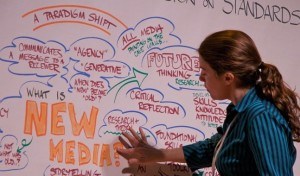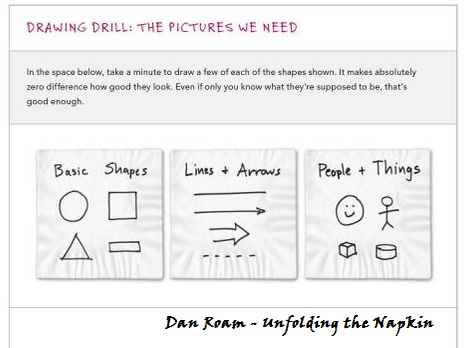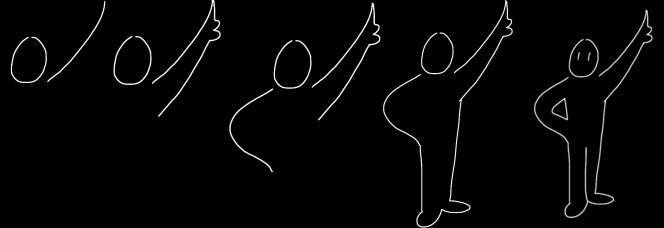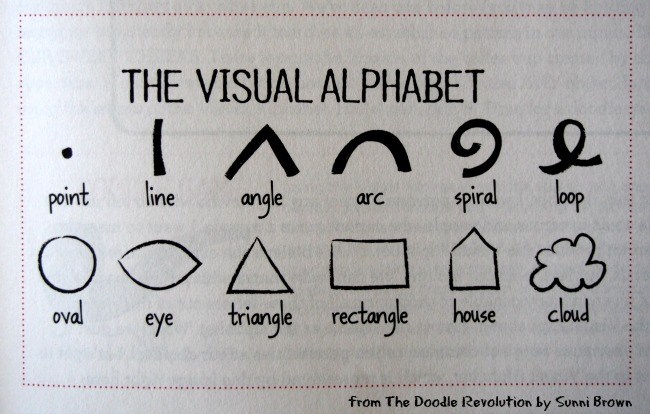“I can’t draw to save my life”
“I credit myself with zero artistic ability“
“I simply cannot draw“
These are all comments left by *you*, my readers, when I’ve been waxing lyrical about the fun and benefits of creating storymaps for recording holiday travel memories, rather than taking what has, to date, been the more traditional route of filling travel journals with walls of words.

Story Map creation of my trip to Kakadu in the Northern Territory, Australia (Click on the image to read the whole post)
The majority of *you* feel quite convinced you “can’t draw for toffee“.
Which is strange, since every one of us in our childhood created beautiful fun filed drawings of our family…
and the house we lived in…
all of which were much admired, were complimented upon and invariably took pride of place on the fridge door until either another masterpiece superseded it or it became dog eared from loving glances as people got the milk out!
We all know we used to draw (despite doing our best to deny the fact).
But it’s a little harder to ignore when you come across some anthropological research into the unfolding of children’s artistic activity that confirms:
“across space and time, all children exhibit the same evolution in visual logic as they grow”; they have a “shared and growing complexity in visual language that happens in a predictable order” so
“doodling is native to us“
quote Sunni Brown
 In other words, to communicate visually is inherent in us as a species – we all did it as a child because drawing is in our nature and at that point in our lives it was still totally uninfluenced by any wayward “well-meaning” nurturing that was yet to pull the portcullis down.
In other words, to communicate visually is inherent in us as a species – we all did it as a child because drawing is in our nature and at that point in our lives it was still totally uninfluenced by any wayward “well-meaning” nurturing that was yet to pull the portcullis down.
Sadly, by the time we get to High School all assignments take on an alphanumeric form, forcing aside and asunder any instinctive visual language skills; and as with any skill left to languish, our development and competency wanes and although the reality is that we haven’t been practicing, we erroneously believe that doodle drawing is only for those who are “artistic” – Ignoring the fact that the only reason someone is proficiently artistic is simply because they’ve maintained their practice and developed a skill as a consequence of that.
The Doodle Revolution
However, there is good news on the horizon –
I’ve been noticing a steady movement forming by visual language proponents who happily are bringing visual literacy back into the main stream –
In 2008 Dan Roam started a series of books:
- “The Back of the Napkin – Solving Problems and Selling Ideas with Pictures” 2008
- “Unfolding the Napkin: The Hands-On Method for Solving Complex Problems with Simple Pictures” 2009
- “Blah Blah Blah: What to do When Words Don’t Work” 2011
- “Show and Tell: How Everybody can make Extraordinary Presentations” 2014
Where he illustrates how only the most rudimentary of line types are necessary to express ideas visually – with no “artistic” skill required.
Then in 2011 Sunni Brown presented this succinct 5 minute TED talk (which has been viewed over a million times) called:
Doodlers Unite
Click here if you can’t see the video above!
In 2012 Mike Rohde brought out The SketchNote Handbook
Again showing – quote Mike Rohde:
“Once you realize how the objects around you are made from these 5 elements [circle, square, triangle, line & dot], it becomes easier to draw all sorts of things.”
 And Rachel Smith, who specialises in visual facilitation, presented a TEDx talk telling the story how at school she was reprimanded for taking illustrative notes in class despite the fact that that was the most natural way for her to make sense of the information being presented.
And Rachel Smith, who specialises in visual facilitation, presented a TEDx talk telling the story how at school she was reprimanded for taking illustrative notes in class despite the fact that that was the most natural way for her to make sense of the information being presented.
Today she makes her living creating visual notes, relishing the value of combining pictures with words, which help lodge information to memory whether in class, recording business meetings or encapsulating conferences.
She asked her TEDx audience mid way in her presentation:
“What do you think is the most common objection I get when I start to teach people how to do visual notetaking?”
Click on the video and listen for just one minute for her answer!
Click here if you can’t see the video above!
“But I can’t draw”
If you listen beyond that, she goes on to demonstrate a step by step guide to get you on the road to incorporate visual language into your everyday world:
- Choosing tools that you’re comfortable with
- Developing an internal library of visual symbols for use on cue, akin to the familiarity we have with our alphanumerics.
- And learning to pick out key points – whether that be notating a talk, or in my case, highlighting one’s holiday adventures.
She also shows line by line how to create a simple ‘star man’ to claim your first visual thinking symbol for a person –
Try it, and tell me, did you surprise yourself?
In 2013 Michael Nobbs brought out Drawing Your Life
And in 2014 Sunni Brown published The Doodle Revolution
Click here if you can’t see the video above
In which she presents a visual alphabet made up of – you guessed it – simple lines, curves and shapes for communicating ideas, thoughts, and memories using visual language.
Can you draw these lines and shapes?
Or how about giving these stick figures a try!
Sketch-noting, doodling and/or story maps are not an artistic skill –
They’re thinking skills that are articulated visually.
You Can’t Draw? I Don’t Believe You.
To finish off, here’s a great 3 minute video by Doug Neill from Verbal to Visual created in 2015 ~
Spelling out the difference between:
- writing, which is a combination of straight and curved lines and
- drawing, which is… ummmm… a combination of straight and curved lines.
Click here if you can’t see the video above
And because his next video, creating a page of icons has so many fun travel related symbols demonstrated, which is so relevant to us here… I couldn’t resist sharing that too!
What do you think?
Is this doodle drawing lark maybe not as scary as you thought?
Tell me in the comments below 🙂
Post Script:
I’ve just found another great You Tube video that will get anyone drawing caricatures 🙂
Click here for the link if you can’t see it above
Why people believe they can’t draw – and how to prove they can | Graham Shaw










Well I’ll be!! I had convinced myself I couldn’t draw. I think I’m maybe too lazy and rely far too much on my iPhone or camera to take photos of places I have visited rather than try to draw a diagram. You have convinced me that I can at least try to draw a little about my holidays rather than just take photos. Thank you.
I think we get tripped up on that word ‘draw’ – Change it to ‘doodle’ and it’s not quite so threatening!
Travel is full of experiences we want to remember f-o-r-e-v-e-r so combining modalities of camera with doodles will definitely aid the memory stakes 😉
Looks doable 🙂 I saw on the web today a Mother told her child that she worked at a college teaching adults how to draw, and her child asked increduously “what they forgot how to do it?”
That’s so funny, but sadly so true! 😉
I guess I can draw and didn’t realise it. Thinking of all of those doodles that used to do through executive meetings …wish I had saved them.
Just think of all those insights now lost to the waste paper bin 😉
I wonder – were you aware of how that doodling was helping you digest what was being discussed?
thank you for the wonderful post and the great little videos. I need to make time in my life to doodle. It’s just a matter of doing it! Thank you!
Doodle drawing is a great way to preserve your travel memories, particularly when combined with beautiful photos 😉
Okay, you’ve convinced me! I’ll try some doodling next time I go sightseeing!
Rachel Heller recently posted..Ill Overseas? 10 Top Tips
Look forward to hearing how you go… and more significantly whether in 5 years time you remember it all better as a consequence 😉
I love doodling! My husband is always telling me to stop doodling on pieces of paper! Now to make the transgression to drawing….Maybe I can do t. Thanks for the encouragement Linda to make us all realise that we can at least try!
If you are doodling Jenny, there is no transgression to make!
Doodle drawing is all we are aspiring to – None of this high falutin arty farty gallery stuff 😉
I am one of the people who would say I can’t draw. But the doodle drawing looks like fine and I might just be able to do that.
If you can shape the letters of an alphabet, you can make the shapes required to doodle-draw!
Although fluency of visual language does come with practice 🙂
I am definitely guilty of saying I can’t draw, but having a 5-year-old who is obsessed with drawing and wants me to do it with him has persuaded me that it is at least worth having a go! (And it’s fun, too.)
It sounds like you have the perfect accomplice Amanda –
Children don’t have the hang ups we adults have of what we can and can’t do. They’re still wonderfully open to the fact that they can do anything so just go for it.
His skill level will of course continue to improve as he simply does it (called by adults – “with practice”) but the beauty of doing it with a 5 year old is that he’d be completely non-judgemental of your efforts so you’d acquire greater dexterity together 🙂
I think of myself as a word person and as not being visual but I take good photographs so maybe I’m more visual than I think. I’ve always enjoyed the little hand-drawn maps Rick Steves puts in his guidebooks so maybe I’ll attempt something like that when I go to Cartagena (at least the inside the walled city part of it). On a side note I wonder if no longer teaching cursive writing will somehow make people less apt to draw. (Random thought)
We’ve all had to create a mud-map to give directions to someone along the way, but maybe because we know that after its been used it will be discarded we don’t put pressure on ourselves that it is something that will be looked upon and judged in its own right at a later date –
Our biggest fear of applying pen to paper is that internal critic we all have living in our heads that sadly gets in the way of our doing exciting things, but which if we overcome will be looked upon with such pleasure in years to come 😉
Dexterity is a human right – Yet I did hear on social media of teachers marking students down because they’d be told not to use cursive writing – I’m shuddering 🙁
Funny, when I was working in Staff Development, story maps were used so often. Since retiring I’ve only done it once and it was so helpful in figuring out my future journey. Think it would be great to incorporate into my travel journeys…..if only I would slow down and take the time!
With all that practice, you’d be a natural!
I think it would be wonderful to incorporate the practice back into your travels…
In 5 years time, as memories fade, you’ll be so over the moon you did 😉
Well, you’ve certainly got me rethinking the idea that I can’t draw. My daughter gave me a coloring book recently and I’ve enjoyed getting back to that, so doodling and drawing may not be far behind. Thanks for the inspiration!
Excited to hear you’ve started to wield some pencils again Julie!
Maybe try extending the image that you’re colouring in a little beyond the border and so add a few of your own flourishes and who knows where that could lead 😉
This post should take the fear out of drawing for anyone! So many give up before they even try anything creative. Such simple techniques with such effective results! Perhaps people who think they aren’t creative are more afraid of making a mistake?
Exactly that Betsy –
Once we’ve learnt how to write, our education system totally focusses on the alphanumeric language to communicate and visual language that we used up until kindergarten is forgotten –
We don’t have an embarrassment of writing in front of someone because we’ve all maintained our practice.
But doing something we haven’t tried for years is akin to stepping out on a tennis court and expect to play Federer when you haven’t picked up a racquet since Primary School 😉
We fear making a fool of ourselves so our inner critic (that noisy chattering monkey) convinces us not to try at all and instead excuse ourselves with the “But I can’t draw” line!
So true, Linda. I used to love drawing when I was much younger … horses being my ahem, specialty! At school I was told in art class that my ideas and attempts to pass art exams didn’t meet the grade, and words quickly took over and I changed my course. I love how you give us all confidence to at least try, and your videos are useful and the doodles make it all seem so easy. I think a Linda doodle workshop is in order?
So was this teacher an art “expert” Jo?
Who is to say that before they put their big foot in it, you were not on the road to being the next avant garde sensation?
Communication is in our genes – But the method we use is no longer merely a question of nature as our education system, as you have demonstrated, nurtures and bends us the way academics have decided is “the” way –
You could equally have been told in school you can’t ‘write’ because your “ideas and attempts to pass [writing] exams didn’t meet the grade” and you would now be sharing your love of horses with the world! 😉
Hello Linda. We totally love this. We totally get it. We really identify with the children’s drawings that you’ve included at the top of your post! Bravo!
Wanda recently posted..Apple Girl’s Top Tips for Healthy Living
So pleased you loved Asa’s drawings at the start of the post ~
They are gorgeous!
I think its all to easy to forget that writing is not the only way to share ideas and communicate so I’m thrilled you incorporate doodle drawings at Art Partners 🙂
You know what annoys me about people like you,who can draw? Of course I can draw a flattened U, 3 straight lines etc – those are virtually letters which was your point. But representing any other objects means you have to “see” them. I know what a human looks like but my proportions are all wrong because I don’t “see”, I retain the picture as a set of words, definitions. The head is showy arms too long, asymmetrical,etc. Hope you get my point! I find it difficult to retain and then represent the image with a pen but I can describe it in words!
Hi Jon ~ Thank you for your great comment.
When I say “draw” I’m not of course talking about an artist’s rendition, which requires years of practice – I’m talking about using symbolic type icons that we innately use as children.
Visual language is not only quicker to notate, it can convey an essence in a few doodley twirls and bring back the message with a glance. 🙂